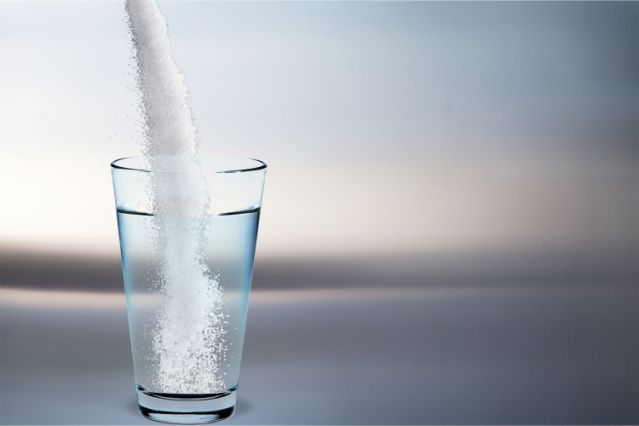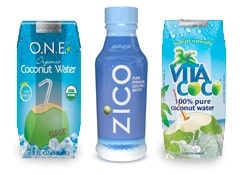
All athletes are aware about the importance of hydration and its direct impact on performance. Drinking water has been drilled into our brains by coaches and health teachers since we were kids. And for good reason, just a 2% level of dehydration (i.e. sweating out 2% of your body weight during exercise) will result in a negative performance outcome.
The six main electrolytes we consume in our diets are sodium, chloride, magnesium, potassium, phosphorous and calcium. Sodium is the most abundant electrolyte in the standard American diet, but that’s not necessarily a bad thing for athletes.
When we sweat we lose proportionally more sodium and chloride than other electrolytes. In fact, the ratio of sodium to potassium lost when sweating is typically about 4:1. But this is just an estimation and still has individual variance. If you’ve ever sweat in a black t-shirt and noticed a white outline around that area, that means a greater concentration of your sweat is sodium.
Salt (sodium chloride) and sodium carry a negative connotation due to possible links with heart disease. But as time has passed we’ve learned that heart disease is far too nuanced to blame on one nutrient. Regardless, many health conscious individuals still try to limit their sodium intake with this fear in mind. Physique competitors may limit sodium intake due to fear of water retention.
However, sodium is a critical electrolyte for athletic performance in sport and also muscle pumps for bodybuilders and physique competitors. So it does serve an important function and should not be limited in this population.
With all that being said, sodium is pretty easy to get in the diet. Most of the savory foods we eat contain adequate amounts of sodium. If your diet is of the “cleaner” variety you could easily add salt to any meal. You could even opt for something like pink himalayan salt which has other minerals on top of just sodium chloride.
The problems with electrolyte supplements
Each individual is different, but as a whole it seems like most people are lacking when it comes to potassium and magnesium. The easy solution would be to take a supplement, but there are limitations.
If you’ve ever looked at potassium pills, you may have noticed that they are always 99mg. Seems strange when you consider the daily recommended intake is 4,000mg. The reason for this is actually due to a legal issue. Potassium regulates nerve and heart function. In a very morbid example, potassium chloride is actually part of lethal injection due to its ability to stop the heart (obviously this is a MASSIVE dose).
Electrolyte powders are able to circumvent this rule because they are considered food products and digest differently than pills. They contain far more than 99mg and are coupled with other electrolytes like sodium, chloride, magnesium, and calcium.
The first problem with electrolyte powders is that you have no control over the ingredients. More importantly, you have no control over the potency. The product is what it is and you can’t really adjust anything since it has multiple ingredients in a fixed ratio.
Take something like whey protein powder for example. Whey protein is basically the only ingredient. If you want more, you use multiple scoops. If you want less, you use half a scoop. You can’t do this with an electrolyte powder since there is a fixed ratio of multiple ingredients. You’d have to find the perfect blend based on your specific needs as an individual, which is very difficult.
In addition, there is no gold standard for electrolyte ratios. If you’ve ever shopped for a branched chain amino acid supplement, you will notice most of them come in a 2:1:1 ratio. This has been deemed optimal for BCAA supplements. With electrolytes, individual needs vary greatly due to the length of the workout, how much the person sweats, the content of that sweat, the climate they live in, etc.
Another common problem with electrolyte supplements is the magnesium content. Magnesium is important for muscle contractions and other internal bodily processes. The problem is that supplementation can lead to gastrointestinal issues and the occasional mad dash to the bathroom.
The truth is, you actually don’t lose much magnesium or calcium when sweating. So unless you sweat excessively you can get adequate amounts of both from a quality, whole foods diet. This is an important tidbit when considering an alternative to ready made electrolyte powders.
How to Make Your Own
With this in mind, we now know that magnesium and calcium aren’t critical elements of an electrolyte drink. They’re more of an added bonus. The keys to an electrolyte drink are sodium chloride and potassium. Potassium is perhaps the most important.
As we mentioned earlier, there is about a 4:1 ratio of sodium lost to potassium lost when sweating. But potassium is at a premium since it’s much harder to come by. This is why we’ll use coconut water as one of the main ingredients in our homemade electrolyte drink.

Coconut water is virtually all potassium from a mineral perspective. We get some additional magnesium and calcium as a bonus, but it is still predominately potassium.
With sodium you have more options since most sports drinks are high in sodium. Powerade Zero and Gatorade Zero are two of the more popular options. These drinks are predominately sodium with miniscule amounts of other electrolytes. But this is a good thing. Now we have full control over the sodium and potassium content of our concoction.
Lacking potassium in your diet? Use a greater proportion of coconut water. Lacking sodium? Use a greater proportion of gatorade. Perhaps you want more carbohydrates. You could opt for G2, regular Gatorade, or a flavored coconut water.
Most electrolyte powders taste terrible. With this method you have countless flavors to choose from. Between the different brands of sports drinks and coconut water you could come up with over 100 flavor combos.
This also gives you the ability to adjust based on the workout. On a lighter day you’d probably need less sodium and carbs. For a longer, outdoor workout on a hot day, you may want to load up with more.
This method allows you to customize the most important variables of your electrolyte drink. In addition it will save you some cash without sacrificing quality.
